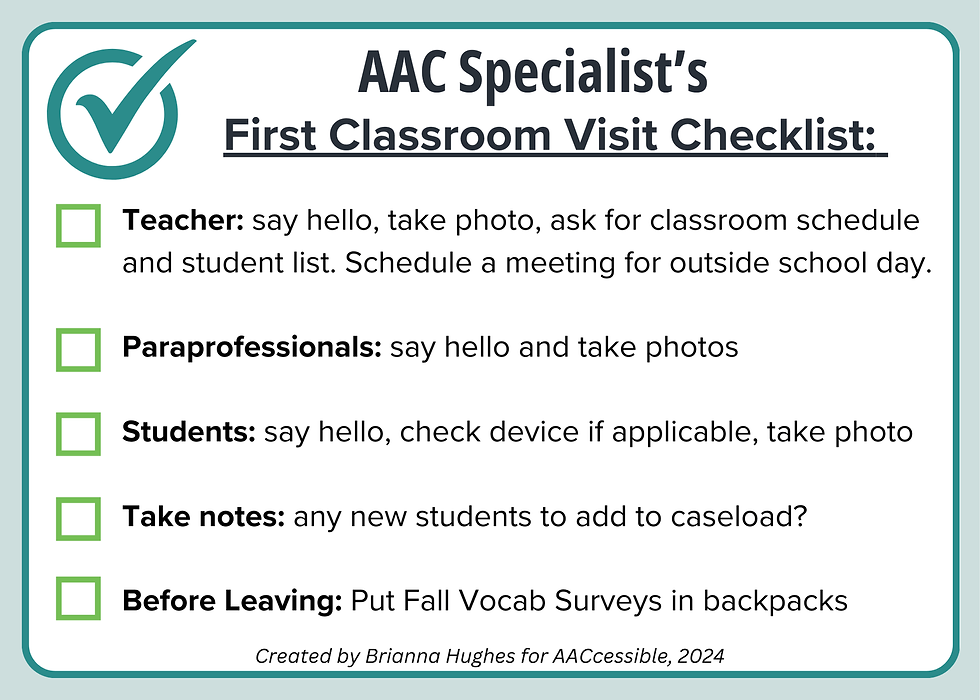My Top 5 To Do’s for the Beginning of the School Year as an AAC Specialist
- Brianna Hughes

- Aug 21, 2024
- 4 min read
Are you new to AAC, or to being an AAC Specialist? This blog post is for you! It’s the first in a series on how to introduce AAC support at school. Today’s tips focus on an AAC Specialist or SLP perspective, and future posts will cover must-do’s for teachers, how to explain AAC to new communication partners, and more!
School is starting! How prepared do you feel to get back to work? This year, I’ll be in a new district and I have all the “first day of school” feelings! I never feel completely ready, but I hit the ground running by having a “to do” list waiting. Here’s how I do it:
1) Meet the Team, Make a Plan
If we have a staff development day before kids arrive, this is a great time to meet the teachers, SLPs, and paraprofessionals! I take notes of everyone’s names and roles. It’s great if I can provide AAC/AT training on these days, but if the district has our team attending other trainings, I might still hand out a communication partner strategies handout along with my contact info.
2) Planning Classroom Visits
If there are any devices that come in over the summer, it’s a high priority to get them in students’ hands. So on the first day of school, I will make sure that any new devices are set up, and then deliver them to classrooms. After that, the rest of the week is devoted to visiting each of the self-contained classrooms for at least an hour. When creating my schedule, I tend to go to the "extensive support needs" classes first. In these rooms, typically 100% of the students have AAC, so I get to see more of my students at a time. I also prioritize classes that have a new teacher, because I know they will need extra reassurance and help!

3) Device Check-Ups
As I go around to classrooms in Week 1, I will take at least a brief look at every single student’s AAC device. For low-tech books, are there any pages missing or in need of repair? For high-tech devices, is the case still functional or did it take a beating during the fun times of summer? Does the vocabulary file look okay, or do I need to restore it from back-up? I take notes about any students who might need loaner devices and/or replacements.
4) Prepare for Vocabulary Updates
AAC users need continuous vocabulary customization and personalization*. To kick off this process, every September I do a big annual update. During the initial classroom visits, I prepare by asking each staff member if I can take their photo, and then I’ll ask, “What do you like the students to call you?” so that I have that information ready for programming into the devices later. I’ll also take pictures of all of the students (unless parents have not signed off on the photo release form: check your district’s information systems and policies ahead of time!).
Then I ask the teacher to send home copies of my “Vocab Update Survey”. This handy questionnaire asks parents and caregivers to let me know about any updates they would like to see to their child’s vocabulary file, and it gives them a few prompts like, “What are your child’s current favorite activities?”.
Tip: when programming the child’s “About Me” page, save versions of it from past years. You’ll gradually form a whole set of pages, for example , “About Me: Age 4”, “About Me: Age 5”, and so on. These are so fun for the AAC user to look back on later!
5) Write and Send a Welcome Back Letter to Families
You might wonder, “Wait, why wasn’t this number ONE on your list?” and there is a very simple reason: I never have a complete caseload list on the first day of school. It takes about a week for me to check in with all the teachers to see who moved away, and who is new to the district. In recent years, I’ve had to divvy up my caseload with someone else, too! Once I have my final list, I’ll send out one big “Welcome back from your AAC Specialist” letter. The content varies from year to year, but the main points are to introduce myself, let them know how to reach me, and tell them that the “About Me” survey will be coming.
What about organization?
After I’ve met everyone and checked on all the devices, it’s finally time to slow down a little. I usually feel overwhelmed by the end of the first week because I have a mountain of notes, but I’m missing some of the key organizational tools that I need! So in the second week, I’ll take time to myself in my office to reread all those notes, and assemble my assessments list, caseload organizer, consultation log, and so on. Then I’m ready to roll! (Literally. Itinerant service provider here!)
What’s on your “to do list” for the first week of school? Next in this blog series: what teachers can do to prepare their classrooms for AAC users!
*Beukelman DR & Light J (2020). Augmentative and alternative communication: Supporting children and adults with complex communication needs. Baltimore, MD: Paul H. Brookes Publishing Co.





Comments